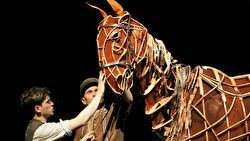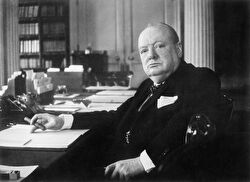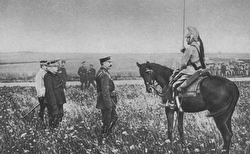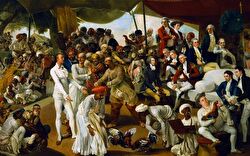
The Eurostar to Brussels was filled with men of a certain age whose observations about military history were interspersed with thundering declarations about frontal assaults on plates of moules frites.
“You’ll have a great time,” a military friend had emailed from Waterloo earlier in the week, “the place is filling up with Herberts.” But what to expect on the field of such dramatic scenes, of desperate valour and abject terror, heroic last stands and magnificent charges, which then foreign secretary Lord Castlereagh had described in the House of Commons as “of such high merit, of such pre-eminent importance, as had never perhaps graced the annals of this or any other country till now”?
There were certainly Herberts aplenty hanging around Waterloo last weekend — a polyglot mass of attention-seekers waiting to be asked by a spectator to pose with them for a selfie. Many had the sort of faces for which casting directors would give their eye teeth. Sticking a shako (a tall military hat) on their heads made them look as if they had just walked out of an Elizabeth Butler canvas. I recalled the remark of the French general watching the charge of the British Light Brigade in the Crimean war, almost 40 years after Waterloo. “C’est magnifique. Mais ce n’est pas la guerre.”
It certainly wasn’t. The re-enactment of the most important battle of the 19th century was sold as education. But mostly it seemed to be entertainment: some 5,000 hobbyists offered the chance to enter a heroic past, performing for the amusement of the leisured 21st-century middle class.
There is no denying the importance of the event: Napoleon’s defeat set the course of European history for decades, arguably for the next 100 years. An anonymous poet hailed 1815 as the year “chronologers henceforth” would “date Britain’s glory”. News had reached Paris in a single sentence — in Latin — delivered to government offices in the middle of the night. It was unsigned. Translated, it read: “The army has been destroyed.” The little Corsican’s 100-day campaign for immortality was dashed.
When dawn broke on June 19 1815, the morning after the battle, local peasants were already at work stripping the dead — and even some of the wounded — of anything remotely valuable, including items of uniform. Soon some of the corpses were naked. Even then, they weren’t safe: specialist scavengers knew there was a lucrative market for teeth, which could later be set in hippopotamus ivory or wood for the benefit of those who had lost their own. “Waterloo teeth” were quickly available in Brussels, Paris and London.
In 1826, Sir Walter Scott asked the history painter Benjamin Haydon whether he knew what had become of a particular British soldier who had once been the painter’s model. He only asked, he said, because he happened to be “in possession of his skull, poor fellow”.
Inevitably, the spoils of war were reduced to what the scavengers had pulled from the pockets of the dead, the dying and the discarded — letters, playing cards and soldiers’ paybooks. Pages from Bibles blew about.
The estimated 118,000 people who attended Waterloo 2015 last weekend belong to a long-established, if not especially glorious, tradition. When the first sightseers arrived on the battlefield in 1815, the corpses were scarcely cold. Exhausted and filthy survivors awoke to see a group of expensively dressed civilians led by a middle-aged man “holding a delicately white perfumed handkerchief to his nose”. The man stepped carefully around the bodies, to avoid soiling his clothes.
Soon, tourists were coming from all over Europe. Sir Walter Scott — the Pam Ayres of his day — had been one of the first celebrity visitors, arriving on the battlefield in August 1815.
Before he had even left Britain, Scott’s publishers were advertising that he would be producing a poem about the battle, available for a modest 3 shillings and 6 pence. It is thin stuff, memorably reviewed with the words:
“How prostrate lie the heaps of slain
On Waterloo’s immortal plain!
But none by sabre or by shot
Fell half so flat as Walter Scott.”
However bad the poem, it sold well and stoked interest. Soon guidebooks were warning tourists of the hazards of “a set of harpies in the shape of guides and relic vendors” who would pester them as they approached the battlefield. When Thomas Cook began his continental tours a few decades later, Waterloo was a key destination.
For those who could not afford to travel, “panoramas” in London offered a virtual reality experience of the fighting. Napoleon’s abandoned carriage was sent on a grand tour of Britain, viewed by more than 100,000 eager spectators. The Duke of Wellington got so fed up with people trying to catch a glimpse of him that he had a grumpy sign erected outside his house stating: “It is wished that the practice of stopping on the paved walk to look in at the windows should be discontinued.”
Last weekend, the battlefield was festooned with mobile hot dog and waffle vans and portable lavatories at 50 cents a go — one unfortunate North American re-enactor collapsed with a fatal heart attack after visiting the facilities: as a comrade observed, he fell on the field of Portaloo.
The “soldiers” I met — from the allied and French “armies” — turned out to be meteorologists, Minnesotan schoolteachers, local government officials, security guards and bricklayers. They were of both genders and all nationalities — Dutch, Spanish and Italians playing Highlanders; Canadians, Americans and even some English pretending to be French infantry.
The great obstacle to plausibility was their age, for the uniforms are costly and re-enactment weekends time-consuming. Stomachs burst from breeches, mutton chop whiskers turned grey years ago. Never in the field of human conflict can such an elderly, unfit army have been assembled. Even some of the camp followers — the “trulls” and “brimstones” in the language of Wellington’s men — looked as if they’d have been better staying at home playing with the grandchildren — assuming they could be dragged away from Call of Duty.
For those who managed to get to Waterloo to see it, the evening re-enactment itself was tremendous, of course. How could it not be, with cannon blasting, muskets blazing and cavalry charging through fields of barley? Accounts of the actual battle speak of such dense grey-white smoke from gunpowder that it was often impossible to see much. In the reconstruction, the battlefield was also quickly shrouded in drifting smoke.
“How do you know when to drop down dead?” I had earlier asked a carehome manager pretending to be an English infantryman.
“When I’m tired, I just lie down,” she said.
What is missing, of course, is the suffering. In Waterloo: The Aftermath, Paul O’Keeffe calculates that for 10 hours 200,000 men, 60,000 horses and 537 guns were doing violence to each other on no more than five square miles of ground. By the time the battle was done, 50,000 human beings were dead or maimed. Horses lay on the ground with their entrails hanging out. Others staggered about the battlefield on three legs.
In contrast, the re-enactors find something romantic in the colourful uniforms, the play-marches, the sleeping out and cooking rations on an open fire. For some, the event has the character of an old comrades’ regimental reunion (some of the re-enactors are, indeed, former soldiers, now playing out war as entertainment).
In 1815, those who had survived the battle were given the grisly task of burying the dead soldiers and horses. They did the best they could. But, throughout the rest of that summer, the place stank of putrefaction and the air was alive with flies.
The smells now wafting about are those of chip fat, wood smoke and the inevitable Belgian drains. The re-enactors are a friendly, engaging bunch who find the whole thing a bit of a laugh. You cannot distrust or dislike their enthusiasm, however much you may wonder about its distance from reality. Most play the part of their own national soldiers, with much specialist knowledge about the character of the regiment to which they belong, and to that extent they are nationalistic. Yet they have also transcended nationalism, with foreign friends and acquaintances who “fight” for other armies.
The area is dotted with patriotic memorials, the finest of which is the new one commemorating the British foot guards who saved Hougoumont farmhouse and probably turned the battle. But I failed to find the monument I’d particularly liked to have seen. It commemorated not an individual or a military unit but a single limb.
The right leg of Wellington’s cavalry commander, the Earl of Uxbridge (who later became the Marquis of Anglesey), was buried in the nearby garden of a Monsieur Hyacinthe Paris, with a stone raised above on which was soon daubed the graffiti:
“Here lies the Marquis of Anglesey’s limb;
The Devil will have the remainder of him.”
The earl’s stoicism when wounded is astonishing. “By God sir, I’ve lost my leg,” he said to Wellington when he was hit by a cannonball. The duke is said to have replied: “By God sir, so you have.”
The shattered remnants of Uxbridge’s leg were later amputated above the knee by a military surgeon, without the benefit of either antiseptic or anaesthetic. Uxbridge was silent as he lay on the kitchen table of a commandeered farmhouse, speaking only, it was said, to ask whether the saw wasn’t a bit blunt. (The saw is now in the National Army Museum, if you’re interested.) The surgeon claimed that, throughout the ordeal, Uxbridge’s pulse never rose above 66 beats to the minute.
Now that would have been a re-enactment worth seeing.
It was, inevitably, the image of the malevolent little Corsican that dominated the commemoration. It is odd, is it not, that we now talk of people “meeting their Waterloo”, as if the true measure of the battle is not success but defeat? So I sought out the three military leaders — Napoleon, Wellington and Blücher — for their ideas of what constituted victory, or the opposite.
Unlike the allied generals, “Napoleon”, a portly little French lawyer, had a separate encampment far away from the tents of the troops he purported to command. There he was attended by half a dozen floozies in bonnets, with endless champagne on tap and a staff of senior officers wearing enough tinsel to decorate the civic Christmas tree of a large industrial town. When I asked him who had won the battle, he claimed that he had. It did not seem worth the effort of continuing the conversation.
“Wellington”, by contrast, a New Zealander by birth, was dressed in a sombre dark jacket with a single star on his chest (so much of the moral significance of Waterloo seems to be expressed in clothing). And at least he had a genuine war wound — a nasty scar on his neck where a ramrod shot from a musket had severed his carotid artery.
How did it happen?, I asked.
“An American civil war re-enactment,” he said. “Near Bath.”
Poor old General Blücher, whose arrival at the head of 100,000 Prussian troops had sealed Napoleon’s fate, merely lamented the fact that the event advertising seemed to have written him out of the story. While “Napoleon” claimed to have become the “legend” of Waterloo and “Wellington” answered the question of who had won the battle by asserting that it was a victory for the British empire, “Blücher” — a heavily-moustached, pensioned-off Leipzig retail director — declared it had been an Anglo-Prussian victory.
But Blücher had the best answer to the question of what was the point of all this noisy reconstruction. “Politicians talk about building a modern Europe,” he said. “We live it.”
Of course, he was being pious. Most of us, moreover, wouldn’t choose to spend a June weekend wearing heavy, uncomfortable clothes, running around pretending to kill people. But at least this way, nobody dies. And that, surely, is a good thing. Yet there is something troubling about people entertaining themselves and 100,000 spectators by play-fighting upon such blood-soaked soil.
But the attitude of “Blücher” was certainly preferable to the crowd of French tourists outside Napoleon’s camp, who kept bellowing “vive l’empereur!” every minute or so, hoping to make the little chap appear. They are evidence that the country has not grown out of a rather absurd cult. The French president had declined the invitation to attend Waterloo 2015 — and, sadly, not out of belated recognition that Napoleon was a monster.
In contemporary shorthand, “Brussels” means grand plans and diktats — and so it was perhaps not surprising that the event’s live commentator, a francophone Jeremy Clarkson, should call Napoleon’s soldiers “supermen”, while constantly referring to the allied army as “les Anglais”, claiming it was largely foreign mercenaries commanded by “ancien régime toffs”. The nations that dispatched France’s little dictator need to be reminded from time to time that no good deed ever goes unpunished.
Even in the immediate aftermath of the battle, interesting and respectable figures such as the writer William Cobbett and the poet Lord Byron were arguing that instead of extinguishing Napoleon’s dream, we should have supported him (for Byron, Wellington was “the best of cut-throats” and Castlereagh an “intellectual eunuch”). More recently, a number of clapped-out English controversialists have succumbed to dictator worship, and have had some amusement from blowing raspberries at the whole anniversary. Apparently, by making the world safe from Napoleon, Wellington’s victory was a triumph for the forces of despotism, monarchy and darkness.
Certainly, unlike commemorations for the first and second world wars, the moral certainties of victory are less clearly felt at Waterloo. But — whether we take the re-enactment seriously or not — let us remember that Napoleon treated power as a family business, plundered the states he conquered, created a police state, subjugated women and reinstated slavery. It is a little difficult to see how the world would have been a better place had he triumphed.
That the strutting little Corsican hoped he might live out his days as an English country gentleman says it all.
Article courtesy of the FT Magazine. Original found here.



